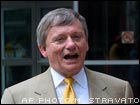
NEW YORK (CNN/Money) -
Federal prosecutors questioned a second witness Wednesday in their effort to prove that Arthur Andersen LLP purposefully destroyed documents after it knew of a federal investigation into Enron Corp.'s accounting practices.
Spencer Barasch, the Securities and Exchange Commission's associate district administrator, said Wednesday that a Wall Street Journal column, "Heard on the Street," of Aug. 28 prompted regulators to begin looking at Enron's accounting.
The SEC became interested when Enron CEO Jeff Skilling resigned after only six months on the job, Barasch said. The WSJ story suggested some questionable accounting practices at the energy trader and also highlighted Skilling's departure. At that time, Enron was still one of the largest corporations in the United States based on revenue.
The agency also began scrutinizing Andrew Fastow, Enron's then Chief Financial Officer, and his relationship with Enron. In an apparent conflict of interest, Fastow managed partnerships that did deals with the energy trader. Fastow is credited as the mastermind behind Enron's complex web of partnerships that eventually led to the company's collapse. Enron ousted Fastow on Oct. 24, 2001.
The SEC did not send a letter to Enron requesting more information until Oct. 17, Barasch said. The previous day, Enron had announced it would take a $618 million loss for the third quarter of 2001. On the same day, Oct. 16, Enron said it would take a $1.2 billion writedown against the company's value.
On cross-examination, Andersen's lead attorney Rusty Hardin ridiculed the SEC's relationship with the newspaper.
"Should there be a hotline between the SEC and the Wall Street Journal?" he said.
| |
 Related stories
Related stories
| |
| | |
| | |
|
The Texas attorney also hammered away at the agency's failure to notify Andersen.
"Did you contact Arthur Andersen?" Hardin said.
"No," Barasch said.
"Did you send them any letters?"
"No."
"Could you have?"
"Yes."
"Where are the drafts of that letter?" Hardin asked of the notice the SEC sent to Enron in October.
"I don't know," Barasch said.
"Would that be because you shredded them?"
The SEC official did not reply.
Barasch ended his testimony late Wednesday and was followed by Andersen auditor James Hecker. Hecker is one of the people Enron executive Sherron Watkins, the whistleblower that wrote an August letter warning former CEO Kenneth Lay about accounting problems at the company, turned to last year and voiced her concerns.
Hecker is also the Andersen executive that was so concerned about the firm's relationship with Enron Corp. that he set his worries to song.
Duncan could take stand this week
Meanwhile, attorneys for fired Andersen audit partner David Duncan appeared before Judge Melinda Harmon, who is also overseeing Andersen's criminal trial. Duncan is the government's star witness against Andersen, which fired Duncan in January after he directed the shredding of Enron documents.
Duncan in April agreed to plead guilty to one count of obstruction of justice and admitted to destroying documents in an attempt to thwart the government's investigation.
Barry Flynn and Sam Seymour rigorously objected Wednesday to an attempt by Andersen to force the lawyers to produce their personal notes on Duncan's talks with congressional investigators.
"The information is privileged and not admissible," Flynn said.
Judge Harmon is expected to deliver her ruling Thursday morning.
If Harmon does deliver her judgment, Duncan could testify on Friday, Flynn said. Duncan had been expected to take the stand Wednesday but his testimony got bumped, he said.
But the Justice Department is determining when the former audit partner will testify. "The government hasn't told us when they want him there," Flynn said. "But we are ready."
When Andersen officially knew
When Andersen actually knew of the federal investigation into Enron is one of the focal points of the court case.
According to the Justice Department's March 14 indictment of Andersen, Enron told the accounting firm of the SEC investigation on Oct. 19. The shredding of Enron documents began on Oct. 23.
 |
|
| Rusty Hardin, Andersen's lead attorney |
"The shredder at Andersen's office at the Enron building was used virtually constantly and, to handle the overload, dozens of large trunks filled with Enron documents were sent [to] Andersen's main Houston office to be shredded," the March indictment against Andersen says.
Andersen, in a March 15 response to the indictment, said the documents were destroyed before it had received a subpoena and employees could have considered the document destruction as proper.
On Nov. 8 the SEC served Andersen with a subpoena and members of Andersen's team on the Enron account were alerted that there could be "no more shredding" because the firm had been "officially served," the indictment said.
Barasch's testimony Wednesday morning followed another government witness, Thomas Newkirk, the SEC's associate director of enforcement. Newkirk on Tuesday described Andersen's prior entanglements with the SEC and pointed to the firm's probationary status with the Commission.
Last summer Andersen agreed to pay the SEC $7 million to settle charges related to its work for trash hauler Waste Management, producing the largest civil penalty ever against a Big 5 accounting firm. More importantly, as part of the settlement with the SEC, Andersen agreed to an injunction that forbade it from future wrongdoing.
Houston-based Enron, which filed the largest bankruptcy in U.S. history on Dec. 2, allegedly used thousands of off-the-book partnerships to hide nearly $1 billion in debt and inflate profits. Andersen, as Enron auditor for 16 years, signed off on the company's financial statements.

|

